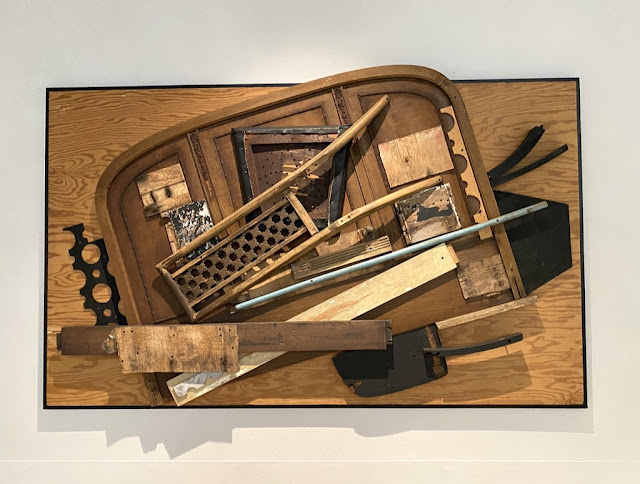Procuratie Vecchie
Louise Nevelson – Persistence
In the historic rooms of the Procuratie Vecchie's recently restored 500 year old building, overlooking the Piazza San Marco the exhibition Louise Nevelson - Persistence - until September 11 - is curated by Julia Bryan-Wilson. Organized by the Louise Nevelson Foundation to mark the sixthieth anniversary of Nevelson's 1962 appearance at the Venice Biennale, this show presents over sixty works spanning some thirty years that together underscore her extraordinarily inventive manner of combining materials, including well-known monumental black modular walls and smaller, lesser-known collages that feature a range of colors and were made with everyday stuff like newsprint, flattened bits of metal, cardboard, foil, sandpaper, and fabric. It is worth noting that, when she began making assemblages, few besides her were hammering together pieces of wooden debris.
"In fact, an ethics of reuse was central to Nevelson's artistic approach.
From her impoverished days in the 1950s trawling construction sites and gutters-rescuing everything from liquor crates to discarded doorknobs-to her years
as an acclaimed and financially stable artist, she remained committed
to reanimateing found objects as she incorporated them
into her sculptures."
Julia Bryan-Wilson
curator
In Nevelson's Artillery Boxes installation, she appropriates - ammunition boxes - that are closely associated with the masculine activity of war, repurposing them to her own ends. Her sculpture renders the ammunition boxes dysfunctional - transfiguring them into containers for abstraction - while at the same time harnessing their formal possibilities as artillery for her own artistic ambitions.
Louise Nevelson - Artilliery Boxes Installation
"..her technique of building works out of ordinary domestic things, often rescued from garbage heaps, has implications that are connected to her status as an immigrant and a woman - her Jewish family left present-day Ukraine when she was a young child . In one of her works in Persistence exhibition from the later part of her career - an untitled collage of 1985 - she has taken a broom and a blue dust pan and affixed them to a black background, leaving them as recognizable tools of the feminist labor of housework but also estranging them in their presentation as a study in textural contrast, from their functionality."
Julia Bryan-Wilson
This room evokes Nevelson's pioneering work in creating immersive sculptural environments during the 1960s and 1970s - such as her installation for '62 Biennale - in which she would often paint the walls to match the color of the works. Her two monumental works related to the series Nightscapes evoke rectilinear shapes of nocturnal cities. Nevelson created these wall reliefs by accumulating smaller objects inside individual cells of vintage printer's drawers, which became grid-like containers for miniature worlds, suggesting the teeming simultaneity of life in the city.
I don't want color to help me."
Louise Nevelson
declared aged 9
Nevelson remained committed to the color black throughout her career. However, in the early 1960s, she began making wood assemblages in white and gold for the first time. Her first works in white were exhibited at MoMa in 1960 under the title Dawn's Wedding Feast. Although she subsequently disassembled the elements into individual works, the exhibition established the 61-year-old artist as a pioneer of Installation Art, a term that had yet to be invented. Here, one of the largest works from the original show in New York is presented with two other sculptures and in dialogue with The Golden Pearl - not shown - as well as, one striking wall from Black Garden series of the 1970s.
"I go to the sculpture, and my eye tells me what is right for me...
Sometimes it's the material that takes over; sometimes it's me that takes over.
I permit them to play, like a seesaw. I use action and counteraction, like music, all the time. Action and Counteraction. It is always a relationship -
my speaking to the wood and the wood speaking back to me."
Louise Nevelson
Moon Spikes from 1953, is the earliest piece in the exhibition; its painted black monochrome surface, somewhat rag-tag assortment of wooden scraps that have been arranged to indicate a kind of cityscape, and largely frontal directionality announces some of the aesthetics conceits that would continue to interest Nevelson until the end of her life in 1988.
Louise Nevelson – Persistence
Louise Nevelson
Please Note
The text is mostly edited from - Louise Nevelson - Persistence - exhibition pamphlet written by the curator, Julia Bryan-Wilson.











